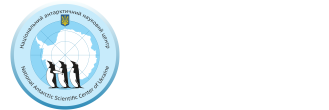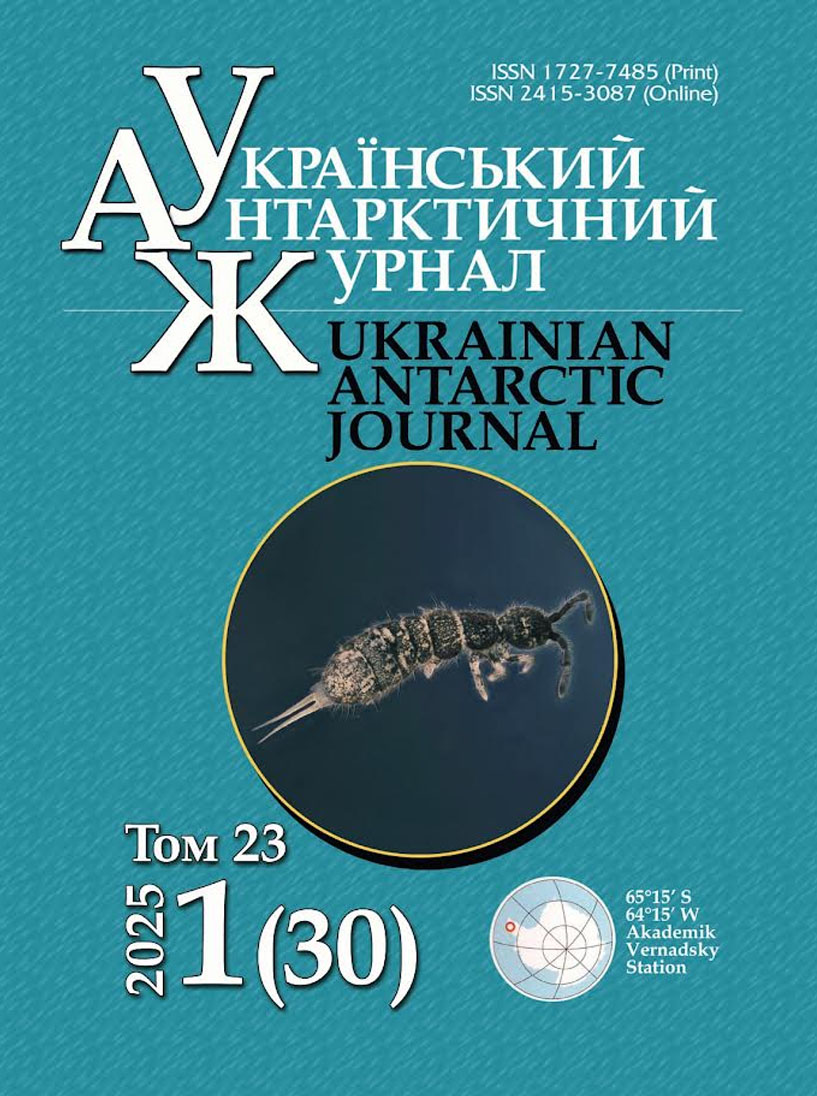Дослідження мікропластику в донних відкладах акваторії антарктичної станції «Академік Вернадський»
- Антарктичний півострів,
- забруднення,
- мікроскопічні дослідження,
- поверхневий шар донних відкладів,
- Раманівська спектроскопія
- штучні полімери ...Більше
Авторське право (c) 2025 Український антарктичний журнал

Ця робота ліцензується відповідно до Creative Commons Attribution-NonCommercial-NoDerivatives 4.0 International License.
Анотація
Незважаючи на віддаленість Антарктиди від потужних джерел антропогенного впливу, її природне середовище зазнає змін через діяльність наукових станцій, туризму, транспортних комунікацій та видобутку біоресурсів. У роботі представлено розподіл штучних полімерних частинок (мікропластику) у верхньому шарі донних відкладів в акваторії поблизу станції «Академік Вернадський». Метою дослідження є виявлення мікропластика в геологічних компонентах і адаптація лабораторного циклу обробки проб та ідентифікації частинок. Зразки були відібрані в 2022 році в ході сезонних польових робіт на глибині від 4 до 60 м. Зокрема, дослідження охопило проби донних відкладів з морських проток на різній відстані від антарктичної станції. У більшості зразків був присутній мікропластик, який був кількісно визначений та класифікований за морфологією. Передбачуваний мікропластик був досліджений методом раманівської спектроскопії (дифракційний монохроматор МДР-23), в результаті дослідження були виявлені такі полімери, як поліпропілен, поліетилен і поліетилентерефталат. Деякі частинки (в основному волокна), що морфологічно не піддаються спектрометричному дослідженню, були ідентифіковані як штучні полімери термічними методами без хімічного аналізу. Для розуміння можливого зв’язку вмісту мікропластиків в поверхневих донних відкладах з природними та антропогенними факторами було досліджено речовинний та гранулометричний склад осадів, проаналізовано результати аналогічних досліджень, що проводились на інших полярних станціях в межах Антарктичного півострова. Мала кількість проб донних відкладів, задіяних в дослідженнях, не дозволила встановити якісний зв’язок між факторами розподілу глибин, гранулометричним складом проб донних відкладів та загальною кількістю підтверджених фрагментів МП. Таким чином, публікацію слід вважати попереднім, оглядовим та методично показовим дослідженням щодо ідентифікації частинок мікропластику у донних відкладах акваторії, що прилягає до Української антарктичної станції.
Посилання
- Antacli, J. C., Di Mauro, R., Rimondino, G. N., Alurralde, G., Schloss, I. R., González, G. A., Morales, S., Ottero, A., & Vodopivez, C. (2024). Microplastic pollution in waters of the Antarctic coastal environment of Potter Cove (25 de Mayo Island/King George Island, South Shetlands). Science of The Total Environment, 915, 170155. https://doi.org/10.1016/j.scitotenv.2024.170155
- Balks, M. R., Paetzold, R. F., Kimble, J. M., Aislabie, J., & Campbell, I. B. (2002). Effects of hydrocarbons spills on the temperature and moisture regimes of Cryosols in the Ross Sea region. Antarctic Science, 14(4), 319–326. https://doi.org/10.1017/S0954102002000135
- Barnes, D. K. A., Walters, A., & Gonçalves, L. (2010). Macroplastics at sea around Antarctica. Marine Environment Research, 70(2), 250–252. https://doi.org/10.1016/j.marenvres.2010.05.006
- Cincinelli, A., Scopetani, C., Chelazzi, D., Martellini, T., Pogojeva, M., & Slobodnik, J. (2021). Microplastics in the Black Sea sediments. Science of The Total Environment, 760, 143898. https://doi.org/10.1016/j.scitotenv.2020.143898
- Cunningham, E. M., Ehlers, S. M., Dick, J. T. A., Sigwart, J. D., Linse, K., Dick, J. J., & Kiriakoulakis, K. (2020). High abundances of microplastic pollution in deepsea sediments: Evidence from Antarctica and the Southern Ocean. Environmental Science and Technology, 54(21), 13661–13671. https://doi.org/10.1021/acs.est.0c03441
- De-la-Torre, G. E., Forero López, A. D., Colombo, C. V., Rimondino, G. N., Malanca, F. E., Barahona, M., & Santillán, L. (2024). Low prevalence of microplastic contamination in the bottom sediments and deep-sea waters of the Bransfield strait, Antarctica. Chemosphere, 364, 143310. https://doi.org/10.1016/j.chemosphere.2024.143310
- Deprez, P. P., Arens, M., & Locher, H. (1999). Identification and assessment of contaminated sites at Casey Station, Wilkes Land, Antarctica. Polar Record, 35(195), 299–316. https://doi.org/10.1017/S0032247400015655
- De Witte, B., Devriese, L., Bekaert, K., Hoffman, S., Vandermeersch, G., Cooreman, K., & Robbens, J. (2014). Quality assessment of the blue mussel (Mytilus edulis): Comparison between commercial and wild types. Marine Pollution Bulletin, 85(1), 146–155. https://doi.org/10.1016/j.marpolbul.2014.06.006
- GESAMP (2019). Guidelines for the monitoring and assessment of plastic litter in the ocean (GESAMP Reports and Studies No. 99). Retrieved March 10, 2024 from http://www.gesamp.org/site/assets/files/2002/rs99e.pdf
- Iemelianov, V., Nasiedkin, Ye., Kukovska, T., Koshliakova, T., Fedoronchuk, N., Shuraiev, I., & Yukhymchuk, V. (2024). Exploring the microplastics distribution in the bottom sediments of the western Black Sea. Visnyk of Taras Shevchenko National University of Kyiv. Geology, 4(107)/2024, 104–113. http://doi.org/10.17721/1728-2713.107.13
- Imhof, H. K., Schmid, J., Niessner, R., Ivleva, N. P., & Laforsch, C. (2012). A novel, highly efficient method for the separation and quantification of plastic particles in sediments of aquatic environments. Limnology and Oceanography: Methods, 10(7), 524–537. https://doi.org/10.4319/lom.2012.10.524
- Isobe, A., Uchiyama-Matsumoto, K., Uchida, K., & Tokai, T. (2017). Microplastics in the Southern Ocean. Marine Pollution Bulletin, 114(1), 623–626. https://doi.org/10.1016/j.marpolbul.2016.09.037
- Jambeck, J. R., Geyer, R., Wilcox, C., Siegler, T. R., Perryman, M., Andrady, A., Narayan, R., & Law, K. L. (2015). Plastic waste inputs from land into the ocean. Science, 347(6223), 768–771. https://doi.org/10.1126/science.1260352
- Klein, A. G., Sweet, S. T., Wade, T. L., Sericano, J. L., & Kennicutt, M. C. (2012). Spatial patterns of total petroleum hydrocarbons in the terrestrial environment at McMurdo Station, Antarctica. Antarctic Science, 24(5), 450–466. https://doi.org/10.1017/S0954102012000429
- Liebezeit, G., & Dubaish, F. (2012). Microplastics in beaches of the East Frisian Islands Spiekeroog and Kachelotplate. Bulletin of Environmental Contamination and Toxicology, 89(1), 213–217. https://doi.org/10.1007/s00128-012-0642-7
- Mariano, S., Tacconi, S., Fidaleo, M., Rossi M., & Dini, L. (2021). Micro and nanoplastics identification: Classic methods and innovative detection techniques. Frontiers in Toxicology, 3, 636640. https://doi.org/10.3389/ftox.2021.636640
- Markley, L. A. T., Driscoll, C. T., Hartnett, B., Mark, N., Mateos Cárdenas, A. M., & Hapich, H. R. (2024). Guide for the visual identification and classification of plastic particles. https://doi.org/10.13140/RG.2.2.27505.45927
- Masura, J., Baker, J. E., Foster, G. D., & Courtney, A. (2015). Laboratory methods for the analysis of microplastics in the marine environment: recommendations for quantifying synthetic particles in waters and sediments. NOAA Technical Memorandum NOS-OR&R-48. https://repository.library.noaa.gov/view/noaa/10296
- MSFD Technical Subgroup on Marine Litter (2013). Guidance on monitoring of marine litter in European seas. Publications Office of the European Union, Luxembourg. https://mcc.jrc.ec.europa.eu/documents/201702074014.pdf
- MSFD Technical Group on Marine Litter (2023). Guidance on the monitoring of marine litter in European seas – An update to improve the harmonised monitoring of marine litter under the Marine Strategy Framework Directive. Publications Office of the European Union, JRC133594. https://doi.org/10.2760/59137
- Nasiedkin, Ye., Olshtynska, O., Ivanova, G., & Mytrofanova, O. (2022). Studying the suspended matter in Antarctic Peninsula coastal waters to understand the local geological and ecological processes. Ukrainian Antarctic Journal, 20(2(25), 135–150. https://doi.org/10.33275/1727-7485.2.2022.696
- Nuelle, M.-T., Dekiff, J. H., Remy, D., & Fries, E. (2014). A new analytical approach for monitoring microplastics in marine sediments. Environmental Pollution, 184, 161–169. https://doi.org/10.1016/j.envpol.2013.07.027
- Obbard, R. W., Sadri, S., Wong, Y. Q., Khitun, A. A., Baker, I., & Thompson, R. C. (2014). Global warming releases microplastic legacy frozen in Arctic Sea ice. Earth’s Future, 2(6), 315–320. https://doi.org/10.1002/2014EF000240
- Reed, S., Clark, M., Thompson, R., & Hughes, K. A. (2018). Microplastics in marine sediments near Rothera Research Station, Antarctica. Marine Pollution Bulletin, 133, 460–463. https://doi.org/10.1016/j.marpolbul.2018.05.068
- Thompson, R. C. (2015). Microplastics in the marine environment: sources, consequences and solutions. In M. Bergmann, L. Gutlow, & M. Klages (Eds.), Marine Anthropogenic Litter (pp. 185–200). Springer Cham. https://doi.org/10.1007/978-3-319-16510-3_7
- Tin, T., Fleming, Z. L., Hughes, K. A., Ainley, D. G., Convey, P., Moreno, C. A., Pfeiffer, S., Scott, J., & Snape, I. (2009). Impacts of local human activities on the Antarctic environment. Antarctic Science, 21(1), 3–33. https://doi.org/10.1017/S0954102009001722
- Usenko, V. P., Mitropolskii, A. Yu., Osokina, N. P., & Nasedkin, Ye. I. (2007). The content of stable chlororganic pesticides in the bottom sediments of Antarctic seas. Geology and Mineral Resources of World Ocean, 4, 44–55. (In Russian)
- Vermeiren, P., Muñoz, C., & Ikejima, K. (2020). Microplastic identification and quantification from organic rich sediments: A validated laboratory protocol. Environmental Pollution, 262, 114298. https://doi.org/10.1016/j.envpol.2020.114298
- Waller, C. L., Griffiths, H. J., Waluda, C. M., Thorpe, S. E., Loaiza, I., Moreno, B., Pacherres, C. O., & Hughes, K. A. (2017). Microplastics in the Antarctic marine system: An emerging area of research. Science of The Total Environment, 598, 220–227. https://doi.org/10.1016/j.scitotenv.2017.03.283
- Woodall, L. C., Sanchez-Vidal, A., Canals, M., Paterson, G. L. J., Coppock, R., Sleight, V., Calafat, A., Rogers, A. D., Narayanaswamy, B. E., & Thompson, R. C. (2014). The deep sea is a major sink for microplastic debris. The Royal Society Open Science, 1(4), 140317. http://dx.doi.org/10.1098/rsos.140317
- Yevchun, H., Dykyi, E., Kozeretska, I., Fedchuk, A., Karamushka, V., & Parnikoza, I. (2021). Minimizing tourist impact on the Argentine Islands ecosystem, Antarctic Peninsula, using visitor site guidelines approach. Ukrainian Antarctic Journal, 1, 98–116. https://doi.org/10.33275/1727-7485.1.2021.669


